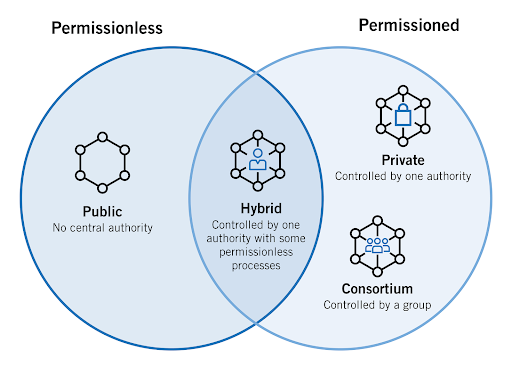Types of Blockchain Networks – Complete Guide To Comprehend

Since we all live in the twenty-first century, we are familiar with concepts like bitcoins and cryptocurrencies. If you work in the finance or investing industry. The most recent and user-friendly technology to hit the market is blockchain.
Blockchain technology has developed tremendously during the past ten years. There are other forms of blockchain, but the first of the four established with bitcoin introduced a public blockchain. The first generation of blockchain technology includes the one that underpins bitcoin.
Highlights
Although it has recently gained prominence, blockchain has its roots in the late 1970s. Hash trees were patented by computer scientist Ralph Merkle, who used them as the foundation for current blockchain technology. These computer science structures, also known as Merkle trees, use cryptography to link blocks together to store data.
We are currently in a stage where different kinds of blockchain technology are available; each performs a unique function and deals with a particular issue or set of issues. Many companies are utilizing these various forms of blockchain technology to reap the benefits.
The decentralization, security, immutability, and transparency of blockchain technology are its main advantages, as was already said. Decentralization refers to database management without a central authority or server. Power is distributed among a group of peers in this system, making it resistant to hacking and data breaches.
In the early days of cryptocurrencies and cryptocurrency investing, understanding blockchain technology was essential, but today it is fair to invest and succeed without giving the issue of blockchains a second consideration.
Even still, blockchains are intriguing since they serve as the foundation for all contemporary cryptocurrencies and because they differ from one another. Here is a quick overview of the blockchains that the cryptocurrency sector uses the most.
A Bit of Background

Source: Digital Information World
- In 2020, the size of the global blockchain market increased by double digits, and this rise is anticipated to continue throughout the following ten years.
- Due to this, businesses like Bitcoin and Square are now the market leaders in terms of blockchain income, while IBM and Ant Financial have filed numerous active blockchain patent applications.
- The United States, then Western Europe are the two regions that contribute the most money to blockchain spending.
- The financial industry spent the most money on blockchain technologies overall.
Let’s first understand why we need blockchain types before discussing them.
When blockchain technology was first made available to the public, it had a use for cryptocurrencies. Although it is difficult to discern the creator’s intentions, it introduced decentralized ledger technology (DLT).
The DLT idea altered how we approach problems in our environment. It enabled organizations to operate independently of a centralized body. Even though distributed technology avoids the drawbacks of centralization, it also raises several new problems that need to be resolved when applying blockchain technology in different situations.
Should we first understand the many sorts of Blockchain networks before moving on to how this revolutionary technology impacts many industries? An organization benefits from blockchain in the following ways:
- Increases trust between parties involved in the business by offering dependable and shareable data.
- Utilizes a distributed ledger that is shared across a network and is only available to People with permission to eliminate siloed data by merging it into a single system.
- A high level of data security is offered.
- Reduce your reliance on middlemen from outside sources.
- Creates real-time, tamper-evident recordings that may be shared amongst all parties.
Although there are already more than two main categories of blockchain, there are two main types. Have a look at the key details in the next sections.
Types of Blockchain Networks – Determine Which One is Best for You

Source: Foley & Lardner LLP
Businesses are starting to put their blockchain initiatives into production in response to Bitcoin’s emergence as a first-generation blockchain technology.
According to Gartner’s 2019 CIO Survey, 60% of CIOs anticipate deploying blockchain by 2022, yet only 5% consider it a game-changing technology. But as Bitcoin and other cryptocurrencies flourish, investors want supply chain transparency, and middleware is created; this is changing.
There are mainly four types of blockchains, Public blockchains, private blockchains, consortium blockchains, and hybrid blockchains. Each of these platforms has its benefits, drawbacks, and idea uses.
Public Blockchain
The first kind of blockchain technology is a public blockchain. Anyone can join and transact on the public blockchain, which uses a distributed ledger technology without requiring permission. Since each user maintains a copy of the ledger, it is an open variety. It indicates that anyone with internet access can look around the open blockchain.
One of the first public blockchains to be made accessible to the general public was the one for bitcoin. Anyone with an internet connection might now carry out decentralized transactions thanks to it.
Use Cases with Examples
- Voting: Using accountability and trustworthiness, authorities can conduct public blockchain voting.
- Fundraising: Organizations and projects may improve accountability and trust by utilizing the open blockchain.
Private or Managed Blockchain
Private blockchains, also known as managed blockchains, are permissioned blockchains under the management of a single company. The central authority decides who is permitted to be a node on a private blockchain.
The central authority may only sometimes accord each node an equal right to execute certain responsibilities. Due to restrictions on public access, private blockchains are only partially decentralized.
Private blockchains can scale better. Scalability is made feasible because only a small number of nodes in a private blockchain are allowed to validate transactions.
Use Case with Example
The business-to-business virtual currency exchange network Ripple and the open-source blockchain application framework Hyperledger are two instances of private blockchains.
Hybrid Blockchain
A hybrid blockchain is a special kind of blockchain technology that combines elements of both private and public blockchains or aims to use the best features of both types of blockchains.
In a hybrid blockchain, transactions and data are made private but can still be validated as necessary by granting access via a smart contract. Although retained inside the network, private information can still be verified.
A private entity can own the hybrid blockchain but cannot alter transactions. A hybrid blockchain enables organizations to set up a private, permission-based system alongside a public permissionless system, giving them control over which data will be made public and who has access to it.
Use Cases
- Hybrid IoT
- Global finance and trading
- Banking
- Supply chain
- Governments
- Enterprise service
One of the advantages of a hybrid network is that it generates more scalability than a public blockchain network and allows for quick and inexpensive transactions. Because only a few nodes are needed to verify transactions on the hybrid blockchain, they are inexpensive.
Consortium Blockchain
The consortium is the last category of the blockchain network. Although they differ significantly from private systems in a few important ways, they are also referred to as federated blockchains. Instead of a single controlling entity, a group of authorities oversees consortium networks. Many entities can even manage the same consortium blockchain.
A consortium network keeps the characteristics of a fully permissioned private network while being partly decentralized. Businesses are using this kind of blockchain more and more, with companies like IBM among them.
Consortium networks can be a successful model for supply chain, financial, and enterprise applications, but they demand a high level of collaboration from all partners. The participating organizations can manage access controls and benefit from a private network’s processing power, security, and privacy.
Use Cases with Examples
- Banking and payments: A bank consortium is a collaboration collection. The nodes that validate transactions are under their control.
- Research: A consortium blockchain can share data and conclusions from the study.
Closing Thoughts
Blockchains are a revolutionary technology with a lot of future potential. Even though there are many distinct kinds, they all have one thing in common: they all use cryptography to establish an accessible and secure database that numerous people can use without any prior knowledge or mutual trust being required.
The landscapes of various sectors have seen significant changes due to blockchain technology. This technology is here to stay; that much is certain.
Since various blockchain platforms currently support the creation of blockchain-based apps, the technology is anticipated to become considerably more widely used. Therefore, entrepreneurs are taking a keen interest in this field and looking for blockchain development company.
If you are willing to disrupt this market, Elluminati Inc is one of the best companies to hire blockchain developers to create blockchain applications by employing modern practices and the best techniques.



